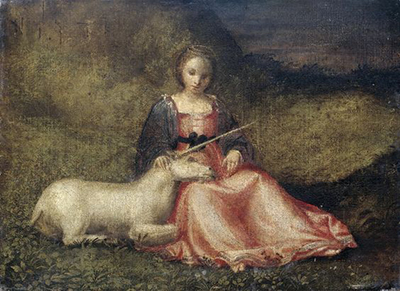This small oil painting, a mere 28 centimetres by 39 centimetres, is packed full of symbolism. It is widely attributed to Giorgione, although some experts reject this attribution citing the painting as anonymous whenever they refer to it.
In the image, a young woman dressed in pink satin, sits on the ground, her feet in front of her, knees slightly bent. Her billowing skirt curves around, hiding her legs and feet and revealing the twin bumps of her knees with the gleam of light on the fabric. Over her dress she has a long loose fabric coat in dark blue, and the dress is gathered under her bosom with a wide black ribbon, tied into a bow. This style of dress shows her extreme youth: she is clearly just beginning puberty. Next to her lies a small unicorn, approximately the size of a new-born foal, albeit with a lengthy, sharp and straight horn that extends past the young woman's body, stretching perhaps twice the length of the unicorn's head.
The young woman is caressing the unicorn with one hand, and it has his head in her lap, seemingly enthralled and devoted to her. The unicorn is, as all the best legends have it, rendered as dazzling white. The background of the painting is obscure: it could be a tree or a cloud that rears behind her, or simply the lie of the land on which she is sitting – it may have been clearer when the painting was new, but time and age have softened it to unrecognisable swirls of brown and blue.
Unicorns were believed to be real in Giorgione's time – after all, visitors described the beautiful beasts and there was even 'proof' of their existence in the form of ancient Greek writings (now believed to be describing rhinoceroses) and their horns, rare and highly valued could be seen in museums and collections (these were almost invariably narwhal tusks). That they were rare only added to their allure, and the myth of their magical healing properties and goodness soon abounded.
Unicorns were, of course, a symbol of chastity and purity in women, and it was reputed that a maiden (virgin) could control a unicorn effortlessly being masters (so to speak) of chastity. Therefore, the inclusion of a unicorn in this image clearly tells us that the young woman is pure, as she able to attract and control the affections of a unicorn.
Some experts say the woman in question is a young Judith before her marriage and subsequent slaying of Holofernes, symbolising her purity and strength of mind. If so, this image is all the more interesting as Judith was soon to be transformed from a figure of purity and all things chaste and good, into a far more ambivalent figure, sensual and tormented by temptations. The painting is the property of the Rijksmuseum in the Netherlands where it is shown as being anonymous.




